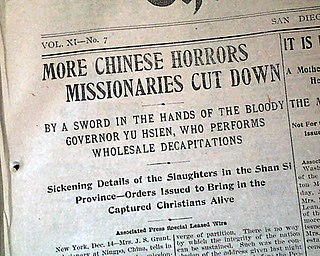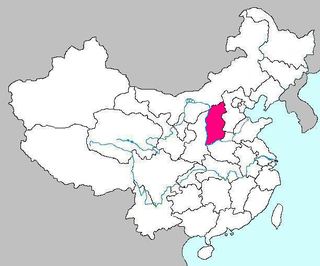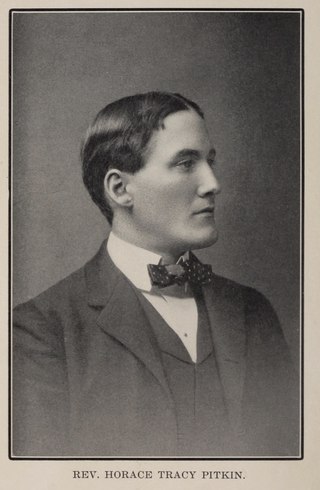
The Boxer Rebellion, also known as the Boxer Uprising or Boxer Insurrection, was an anti-foreign, anti-imperialist, and anti-Christian uprising in North China between 1899 and 1901, towards the end of the Qing dynasty, by the Society of Righteous and Harmonious Fists, known as the "Boxers" in English due to many of its members having practised Chinese martial arts, which at the time were referred to as "Chinese boxing". It was defeated by the Eight-Nation Alliance of foreign powers.

James Hudson Taylor was a British Baptist Christian missionary to China and founder of the China Inland Mission. Taylor spent 54 years in China. The society that he began was responsible for bringing over 800 missionaries to the country who started 125 schools and directly resulted in 20,000 Christian conversions, as well as the establishment of more than 300 stations of work with more than 499 local helpers in all 18 provinces.
OMF International is an international and interdenominational Evangelical Christian missionary society with an international centre in Singapore. It was founded in Britain by Hudson Taylor on 25 June 1865.
Marshall B. Broomhall, was a British Protestant Christian missionary to China with the China Inland Mission. He also authored many books on the subject of Chinese missionary work. He was the most famous son of the anti-opium trade activist and General Secretary of the CIM Benjamin Broomhall and Amelia Hudson Taylor. Thus he was also the nephew of the founder of the mission, James Hudson Taylor.

Arthur Henderson Smith was a missionary of the American Board of Commissioners for Foreign Missions noted for spending 54 years as a missionary in China and writing books which presented China to foreign readers. These books include Chinese Characteristics, Village Life in China and The Uplift of China. In the 1920s, Chinese Characteristics was still the most widely read book on China among foreign residents there.

Chinese Martyrs is the name given to a number of members of the Roman Catholic Church and the Eastern Orthodox Church who were killed in China during the 19th and early 20th centuries. They are venerated as martyrs. Most were Chinese laypersons, but others were clergy from various other countries; many of them died during the Boxer Rebellion.

In the early 19th century, Western colonial expansion occurred at the same time as an evangelical revival – the Second Great Awakening – throughout the English-speaking world, leading to more overseas missionary activity. The nineteenth century became known as the Great Century of modern religious missions.

The Battle of Peking, or historically the Relief of Peking, was the battle fought on 14–15 August 1900 in Beijing, in which the Eight-Nation Alliance relieved the siege of the Peking Legation Quarter during the Boxer Rebellion. From 20 June 1900, Boxers and Imperial Chinese Army troops had besieged foreign diplomats, citizens and soldiers within the legations of Austria-Hungary, Belgium, Britain, France, Italy, Germany, Japan, Netherlands, Russia, Spain and the United States.
The Sheo Yang Mission was a Protestant Christian missionary society that was involved in sending workers to China during the late Qing dynasty. It was founded by the Pigott family in 1892, they had previously been members of the China Inland Mission (CIM). The mission was destroyed and most members murdered in 1900, the work continued through the Baptist Missionary Society.
Archibald Edward Glover (1859–1954) was a British Protestant Christian missionary in China. He served with the China Inland Mission from 1896 to 1900, when he returned to England with his two children after his wife and youngest daughter died during their flight from the Boxer Rebellion.

The Taiyuan massacre took place during the Boxer Rebellion, July 9, 1900, in Taiyuan, Shanxi province, North China. Sources recall that they were killed in the presence of Yuxian, governor of Shanxi. 44 people were killed including children.

The Twain–Ament indemnities controversy was a major cause célèbre in the United States of America in 1901 as a consequence of the published reactions of American humorist Mark Twain to reports of Rev. William Scott Ament and other missionaries collecting indemnities from Chinese people in the aftermath of the Boxer Uprising.

The siege of the International Legations was a pivotal event during the Boxer Rebellion in 1900, in which foreign diplomatic compounds in Peking were besieged by Chinese Boxers and Qing Dynasty troops. The Boxers, fueled by anti-foreign and anti-Christian sentiments, targeted foreigners and Chinese Christians, leading to approximately 900 soldiers, sailors, marines, and civilians from various nations, along with about 2,800 Chinese Christians, seeking refuge in the Legation Quarter. The Qing government, initially ambivalent, ultimately supported the Boxers following international military actions. The siege lasted 55 days, marked by intense combat and a brief truce, until an international relief force arrived from the coast, defeated the Qing forces, and lifted the siege. The failure of the siege and the subsequent occupation of Peking by foreign powers significantly weakened the Boxer Rebellion, leading to its eventual suppression and resulting in increased foreign influence and intervention in China.

Francis Dunlap Gamewell was a Methodist missionary in China. He was the chief of the Fortifications Committee in the Siege of the Legations during the Boxer Rebellion in 1900 and was acclaimed as one of the heroes of the siege.
Francis Huberty James or in Chinese:Xiu Yaochun 秀耀春 was a British Christian Missionary who went to China in 1876 as part of the China Inland Mission (CIM) founded by J. Hudson Taylor (1832–1905).

The Oberlin Band was a group of Christian missionaries in China from Oberlin College in Ohio. Members of the Oberlin Band worked in Shanxi province from 1882 until 1900. During the Boxer Rebellion in 1900, the 15 missionary men, women, and children of the Oberlin Band were among the foreign missionaries executed by order of the provincial government or killed by Boxers and soldiers.

Horace Tracy Pitkin (1869–1900) was a missionary in China of the American Board of Commissioners for Foreign Missions. Chinese Boxers killed him during the Boxer Uprising in 1900. Yale China Mission,, was founded in his memory.

The Protestant mission began in the southwestern Chinese province of Sichuan in 1877, when premises were rented by the China Inland Mission in Chungking. However, compared with Catholicism, which had been spread throughout the province for over two centuries at the time, it grew rather slowly, it was not until the late 1980s that Protestantism experienced rapid growth. The two largest denominations in the province before 1950 were Anglicanism and Methodism.
The history of Baptist Christianity in Sichuan began in 1890 when missionaries began arriving from the United States. Baptist missionaries in Sichuan were organized under the American Baptist Missionary Union, later renamed American Baptist Foreign Mission Society. Missionary activity in China generated controversy among many native Chinese and faced armed opposition during both the Boxer Rebellion and the later Communist movement in China. Although the former did not affect Sichuan so much as some other parts of China, the province was one of the hotbeds of anti-missionary riots throughout its ecclesiastical history.













